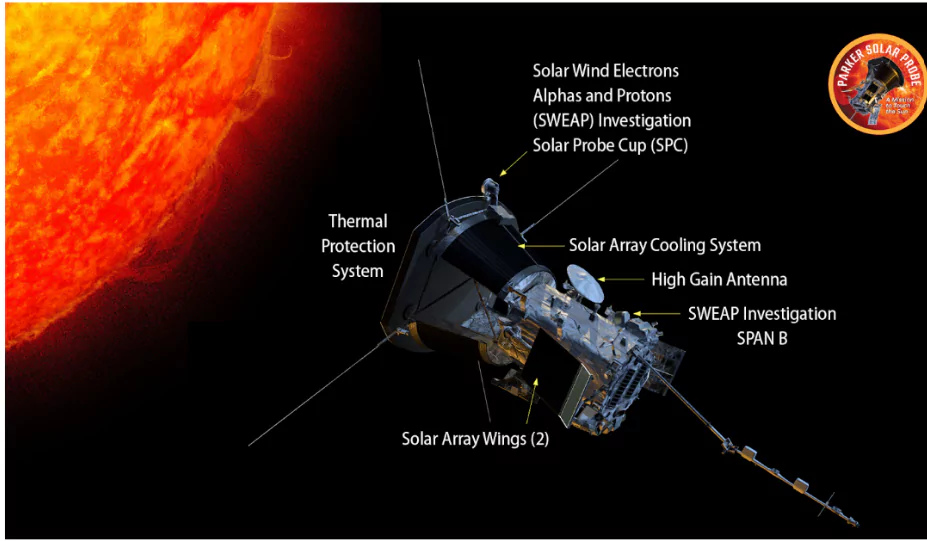The Parker Solar Probe completed its 23rd close approach (known as perihelion) to the sun on March 22 2025, reaching a distance of about 6.1 million kilometers (3.8 million miles) from the solar surface
- Parker Solar Probe was moving 430,000 miles per hour (692,000 kilometers per hour) around the Sun
- First Sun Touch Event: A ‘sun-touching’ event occurred in April 2021 when Parker moved closer to the sun than its Alfvén surface (the height beyond which the solar wind can’t affect the star’s surface)
About Parker Solar Probe
- Mission: The Parker Solar Probe is a NASA mission launched in 2018, designed to study the Sun’s corona and solar wind by attempting a ‘touchdown’ of the sun.
- Named After : The NASA probe is named after the scientist Dr. Eugene N. Parker, who predicted the existence of the solar wind (a stream of charged particles flowing out from the sun in all directions)
- It is the first mission named after a living scientist.
- Mission Design and Management: The Mission is designed by NASA’s Goddard Space Flight Center and Johns Hopkins University Applied Physics Laboratory
- Launch Vehicle: Delta IV-Heavy with Upper Stage
 Goals:
Goals: -
- To trace the flow of energy that heats the Sun’s outer atmosphere (corona).
- To shed light on the sources of the solar wind, the constant flow of solar material escaping from the Sun.
- To explore how solar energetic particles which can make the 93-million mile (150 million kilometer) journey to Earth in under an hour are transported and accelerated.
- Structure: The probe is made from an 8-foot-wide, 4.5-inch thick carbon-carbon composite material shield that can withstand up to 1,370º C to protect against the sun’s intense heat.
- The shield consists of a carbon composite foam sandwiched between two carbon plates.
- The sun-facing side of the probe is coated with white ceramic paint to reflect as much sunlight as possible instead of absorbing it.
- Solar Power Arrays: The probe has two sets of solar power arrays,
- One is located in the shield’s shadow that supplies power to the instruments
- It is on the sun-facing side, which uses a special fluid pump to cool itself while powering the probe during its close approaches.
- Scientific Instruments:
- FIELDS: It measures the electric and magnetic fields of the sun’s atmosphere
- Integrated Science Investigation of the Sun (ISoIS): It observes the energetic particles that cause solar storms
- Wide-Field Imager (WISPR): It takes pictures as it passes through the corona.
- Solar Wind Electrons Alphas and Protons (SWEAP): It records the properties of solar storms
- Faraday Cup: It measures the density of ions and electrons in the solar wind and is made of a molybdenum alloy with a melting point of 2,349º C.
- Achievements of Parker Probe:
- First Spacecraft to “Touch” the Sun: Parker Solar Probe became the first spacecraft to enter the Sun’s corona, its outer atmosphere, in 2021, making measurements from within a star’s atmosphere.
- Dust Free Zones: Parker revealed dust-free pockets near the sun which was assumed to be present everywhere in the solar system created when space rocks weather.
- Magnetic Switchbacks: The probe detected magnetic switchbacks, parts of the solar wind where the magnetic field (created by the collective of charged particles) abruptly bent back on itself.
- Sample Alfvén Critical Surface: The SWEAP instrument established that the Alfvén boundary’s shape has spikes and valleys that wrinkle the surface due to coronal streamers
- Coronal Streamers are giant plumes of solar material rising through the Sun’s atmosphere which were observed but never before measured directly.
![]() 31 Mar 2025
31 Mar 2025

 Goals:
Goals: 